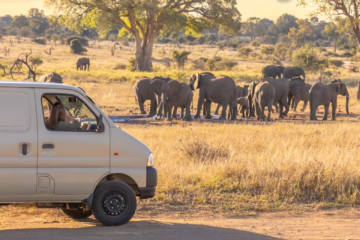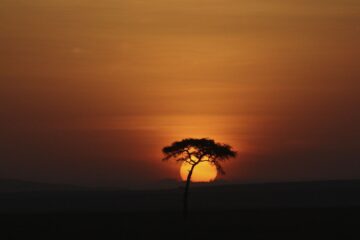The Okavango Delta, known as “the Jewel of the Kalahari” is one of Africa’s top safari destinations. A unique attraction where the great Okavango River never finds the sea, but flows into the Kalahari Desert and fans out into a delta formation. The Okavango Delta supports an impressive concentration of animals and birds – home to the Big 5, numerous antelope species including the rare sitatunga, hippo, wild dog, giraffe, zebra, wildebeest, hyena as well as over 400 different bird species.
A range of activities are on offer including both water-based (fishing, boat trips and mokoro excursions) and land activities (game drives and walking safaris) as well excellent bird watching and star gazing. Some of the safari camps are based on islands in the middle of the delta so only water activities are possible, other camps are situated to be able to offer both land and water-based activities, while some can only offer land activities when the water levels in the delta are low. Accommodation in the camps is almost all tented, with varying levels of facilities and luxury.
For those with longer to spend in the area the Okavango Delta packages well with other destinations in Botswana such as the contrastingly dry Makgadikgadi Pans, the beautiful Savute and Linyanti areas and elephant rich Chobe National Park. Victoria Falls is also a popular extension from Chobe, being only an hour’s drive away.
When to visit?
When deciding on the best time to visit the Okavango there are several factors potential visitors need to take into consideration:
Price
Animal and bird sightings
Weather – temperature and rainfall
Water levels in the delta
“Greenery” of the bush
The general seasons for pricing are:
Low Dec-Mar (“Green Season”)
Shoulder Apr-Jun and November
Peak July-October (dry season, delta in flood)
Something to note for single travellers is that many of the camps don’t have single supplements in the low and shoulder seasons which is a huge saving for solo travellers.
It was always believed that the best time to visit Botswana was in the winter as the bush is dry so animals more easily seen and also wildlife concentrates around the permanent water sources. Winter days are warm but the nights can get very cold making it necessary to carry warm clothing for the evening and early morning game drives. Temperatures can reach the zero degree mark at times. Risk of malaria is also lower in the dry winter months.
The summer months, also commonly referred to as the “Green Season” have become a popular time to visit the Okavango. This is when all the antelope give birth and as a result predator sightings are frequent. It is also the best time for birders – the migrant birds have arrived and many species display their beautiful breeding plumage. The lower prices during these months is an additional draw card. Summer can however get very hot, most of the camps except the really top end super luxury ones are not air-conditioned, plus it is the rainy season so roads can be tricky for guides to navigate when muddy. During the summer months the days are hot and the nights are pleasantly balmy. October needs special mention as it is the hottest month in Botswana with temperatures touching the plus-forty degree mark. Head gear and sunscreen is important for all months.
Botswana is unusual in that some of the rivers are in peak flood at the height of the dry season. The Okavango Delta reaches its peak months (July-Oct) after the last rains of the season have fallen in the area – most the Delta water comes from the highlands of Angola almost two thousand kilometres away. This provides a contrast of dry dusty surrounds and lush green waterways.
End of April to May are pleasant months to visit because the water is starting to rise and push into the delta, but the surrounding bush is still quite green from the rains. Temperatures are comfortable and shoulder season means prices are more reasonable. This would be our personal recommendation of when a good time to visit is taking into account all of the above factors.



0 Comments